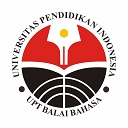Using Vlog in Shokyu Kaiwa's Course to Improve Students’ Speaking Ability
Abstract
The evaluation of Shokyu Kaiwa1 and Shokyu Kaiwa2 courses (basic speaking level 1 and 2) were mainly conducted using role play method, where students in pairs conducted a conversation about a theme within a predetermined duration of time. It is known that this kind of evaluation is considered to be less optimal to explore students' speaking abilities. Conversational material only revolves around simple everyday conversations that have been memorized before, and it is possible that they only memorize certain parts of the conversation. With this background, in this research, a method of evaluation that is approximated to be able to explore the ability to speak more optimally is done through vlog (video blogging) which has recently become a popular thing, especially among young people. This research is a descriptive study, with a sample of the Japanese language students major in the second semester of the year 2018 in Universitas Pendidikan Indonesia. The step taken in this study was stimulating students to prepare what must be discussed first, such as giving a variety of material relating to Japanese culture or Japanese habits. The results of this study showed that the students' speaking ability is increased, and students are conveying the conversation materials more freely. The sentence patterns used by students was not limited to the material that has been taught, but exceeded the sentence patterns given in the second semester. Further, students are able to develop the story materials given previously. Thus, it is known that the use of vlogs in evaluating the learning of the Shokyu Kaiwa course had a positive impact on improving the speaking skills of Japanese Language Education students.
Keywords
Full Text:
PDFReferences
Baran, E. (2007). The Promises of Videoblogging in Education. The Association for Educational Communications and Technology (AECT), International Convention, California.
EDUCAUSE Learning Initiative. (2005). Things You Should Know About Videoblogging. EDUCAUSE. Retrieved from http://www.educause.edu/ir/library/pdf/ELI7005.pdf
Encalada, M. R. (2018). Role-plays as an Assessment Tool in English as a Foreign Language (EFL) Class, Beyond Paper-and-Pencil Tests: Good Assessment Practices for EFL Classes, ISBN: 978-9942-24-111-5.
Iskandarwassid & Sunendar, D. (2015). Strategi Pembelajaran Bahasa. Bandung:Remaja Rosdakarya.
Judiasri, M. D. KOTO RENSHU DALAM PEMBELAJARAN KAIWA (BERBICARA) DI DEPARTEMEN PENDIDIKAN BAHASA JEPANG FPBS UPI. JAPANEDU: Jurnal Pendidikan dan Pengajaran Bahasa Jepang, 2(1), 29-39.
Lestari, N. (2019). Improving the Speaking Skill by Vlog (video blog) as Learning Media: The EFL Students Perspective, International Journal of Academic Research in Business & Social Sciences, ISSN:2222-6990.
Slamet. (2014). Pembelajaran Keterampilan Berbahasa Indonesia. Yogyakarta: Graha Ilmu.
Suryadi, D. (2014). Pengajaran Debat dalam Mata Kuliah Chuukyu Kaiwa untuk Meningkatkan Kemampuan Berkomunikasi dalam bahasa Jepang, Jurnal Pendidikan Bahasa Jepang ASPBJI Korwil Jabar, 8 (2).
Takami. (2004). Shin Hajimete no Nihongo Kyojuho 2, Aruku. Tokyo.
Priana, R. Y. S. (2017). Pemanfaatan Vlog sebagai Media Pembelajaran Terintegrasi Teknologi Informasi, Prosiding Seminar Nasional Pendidikan FKIP UNTIRTA 2017, ISBN 978-602-19411-2-6.
DOI: https://doi.org/10.17509/japanedu.v4i2.19534
Refbacks
- There are currently no refbacks.
Copyright (c) 2019 JAPANEDU: Jurnal Pendidikan dan Pengajaran Bahasa Jepang

This work is licensed under a Creative Commons Attribution-ShareAlike 4.0 International License.
 Published by:
Published by: Department of Japanese Language Education, Faculty of Language and Literature Education
Universitas Pendidikan Indonesia
 Online ISSN: Online ISSN:2528-5548 |

JAPANEDU: Jurnal Pendidikan dan Pengajaran Bahasa Jepang (e-ISSN:2528-5548) lisenced under a Creative Commons Attribution-ShareAlike 4.0 Internasional (CC BY-SA 4.0)


